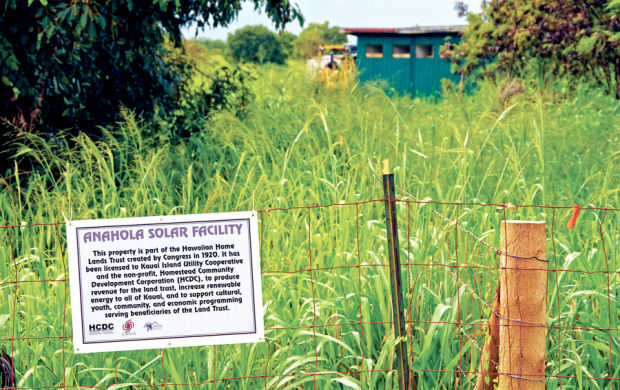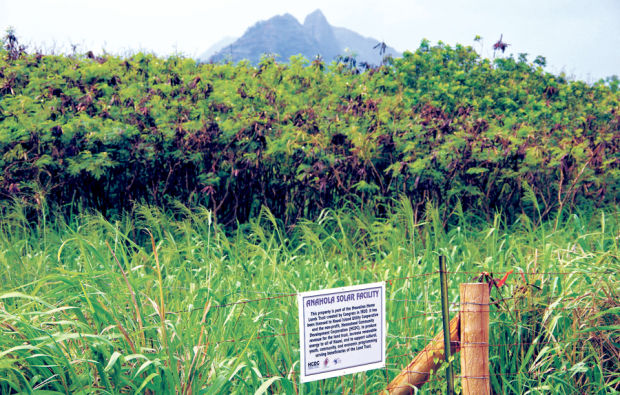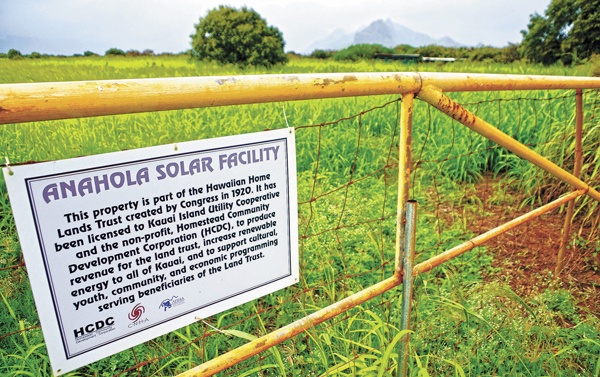LIHUE — Kauai Island Utility Cooperative is one step away from adding a second 12-megawatt solar facility to the Kauai grid. The only thing standing in the way — other than actually building it — is finalizing the terms of
LIHUE — Kauai Island Utility Cooperative is one step away from adding a second 12-megawatt solar facility to the Kauai grid.
The only thing standing in the way — other than actually building it — is finalizing the terms of a lease with the Department of Hawaiian Home Lands.
The U.S. Department of Agriculture Rural Utilities Service recently issued a “Finding of No Significant Impact” for the proposed $50 million Anahola Solar Project.
“RUS has determined that the environmental impacts of the proposed project have been adequately addressed through the (Environmental Assessment) and that no significant impacts to the quality of the human environment would result from construction and operation of the proposed project,” wrote RUS in its recent notice.
The Hawaiian Homes Commission voted unanimously on Sept. 24 to accept the environmental assessment.
The project proposal includes construction of a 53-acre photovoltaic facility, a 5-acre service station and a substation to connect the facility to the grid. The 60-acre project site is on a 422-acre parcel of DHHL land along Kuhio Highway.
If the lease is approved, construction could begin in the first half of 2014.
“That’s pretty much where things stand,” KIUC Communications Manager Jim Kelly wrote in an email. “We’re still talking with the Department of Hawaiian Homelands. The environmental review is done, the financing is in place. Once everything is settled, we could be in construction within a couple of months.”
DHHL Public Information Officer Punialoha Chee could not confirm the status of the lease negotiations with KIUC Wednesday, but said the department is continuing to work with the co-op.
Once operational, the facility is expected to generate more than 23,000 megawatt-hours of electricity per year (equal to 5.2 percent of the total electricity generated in 2010), save co-op customers an estimated $250,000 per month in costs, and replace 1.7 million gallons of oil annually.
In a Nov. 9 release, the Anahola Hawaiian Homes Association announced the establishment of a Solar Project Advisory Committee, which will work with AHHA and KIUC on components contained in a Homestead Benefits Agreement.
“We are really excited,” Kipukai Kualii, AHHA Vice President and the advisory committee’s first chairman, said in the release. “We have a super diverse committee of Anahola leaders, some with farming and ranching expertise, some with business and cultural expertise, some in youth education, and all of us, passionate about the well-being of our Anahola families and all of Kauai.”
Components of the agreement include annual high school level classes on renewable energy technologies and financing, job training and outreach, emphasis on local contracting and providing internships for young adults, according to the AHHA release.
But the project is not without controversy.
Donovan Cabebe, of Kalaheo, said he is against the project because it utilizes Hawaiian homelands for something other than putting Hawaiians into homes.
“As a native to Hawaii, my roots are connected to Anahola, as well as Hanalei, Hilo and every other point in between,” he said. “I’m certainly not a fan of using the land for any other purpose than giving Hawaiians a place to call home.”
A 30-day public comment period on the 588-page environmental assessment, compiled by Planning Solutions of Honolulu, ended June 18. A total of 25 comments, including 17 from government agencies and eight from private citizens, were received by RUS and DHHL.
“The EA identifies thirteen of the comments as substantive; however they did not result in any changes to the content of the draft EA,” states the recent RUS notice.
In his May 21 comment, Kalulani Lovell wrote that those in charge have continued to push the project forward without the support of the Anahola community.
“With all do respect, please stop being condescending and insincere with the people of Anahola,” he wrote. “The main objective here is clearly economics, to even try to allude to your focus being on the environmental impact is just plain rude. We can see with a united eye, the true vision of this project. The people who will benefit from this project moving forward will not be us.”
Stephanie Blakemore is also against the project. She wrote that she was against developing the “tract of sacred land” in Anahola into a “field of solar panels.” Instead, she said the panels should be installed directly onto business and residential rooftops.
“This project is not in the interest of the Hawaiian people who have every right to say what happens on this property, and have said in repeated meetings, no and no again,” she wrote. “You must not allow this plan to go forward, it is wrong and against the intended use of lands that have been set aside for the Hawaiian people.”
But Kualii said the project would be an economic boon to the area. The Anahola Solar Facility would consist of 59,000 ground-mounted photovoltaic modules, each approximately 5.5-feet long by 3-feet wide.
“For us, this project is a nonprofit economic development initiative, which will create job opportunities, educational avenues in the renewable energy field for our kids, and most definitely offer land stewardship responsibilities that the (Hawaiian Homes Commission Act) always intended for us as Hawaiians to have with our lands,” Kualii said in the release.
On Nov. 6, KIUC broke ground on its $40 million, 12-megawatt solar facility in Koloa. When complete, it will be the largest solar project in Hawaii.
Both projects are part of KIUC’s strategic plan to use renewable resources to generate 50 percent of Kauai’s electricity by 2023.
• Chris D’Angelo, environmental reporter, can be reached at 245-0441 or cdangelo@thegardenisland.com.




